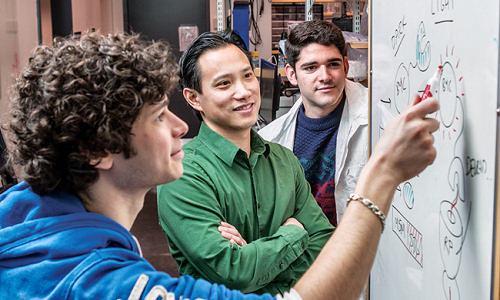It’s not surprising that this challenge from the International Genetically Engineered Machine (iGEM) competition garnered interest from engineering schools across the country. What was surprising was that the competition’s North America Grand Prize winners, Penn Engineering’s iGEM team, had no synthetic biology training when they entered the competition. “Prior to developing their project, the team had practically none of the design or molecular cloning experiences of other teams, and had little understanding of what synthetic biology is,” explains Brian Chow, assistant professor of Bioengineering and the team’s primary faculty advisor.
To obtain the necessary fundamentals, the team of five undergraduates, Daniel Cabrera, Mahamad Charawi, Danielle Fields, Brad Kaptur and Josh Tycko, went to “synthetic biology boot camp,” starting with an intensive one-week training session in molecular cloning at the Penn Genome Frontiers Institute. Under the mentorship of Spencer Glantz, Michael Magaraci, Jordan Miller and Avin Veerakumar, all of whom were responsible for initiating Penn’s participation in iGEM in 2011, the team quickly learned how to apply their individual engineering knowledge to molecular biology. “It helped all of us learn a vast skillset quickly which, for the iGEM competition, was crucial,” says Charawi, a computer science major. “It helped to bring us together.”
Collaboration and Determination Define a Winning Team
That collaborative foundation proved strategic when the team needed to agree on what aspect of synthetic biology to target. “We spent weeks brainstorming ideas and reading papers for inspiration,” says Fields, a bioengineering major. “It took us a while to find a project idea that was both interesting and doable. Ultimately, we chose a project in epigenetics with the target of methylation because all of us were excited about the idea, and we saw a lot of potential.”
Epigenetics reveals how chemical and structural modifications to an organism’s DNA alter heritable traits. Methylation of DNA is a signaling tool that is important in numerous cellular processes, including embryonic development, genomic imprinting, X-chromosome inactivation and preservation of chromosome stability. The team wanted to see if adding this chemical cap to specific sites on a genome could prevent certain genes from turning on. They originally planned on incorporating the use of BioBricks™, modular genetic assemblies that perform a specific function. Like LEGO® construction toys, BioBricks can be linked to create novel circuits for programming cells.
Shortly after receiving the iGEM-provided toolbox, the team ran into their first two roadblocks: there were no tools available to target DNA methylation, and there was no easy way to measure the process. “The most important thing that the mentors and I set out to do was to give the team ownership of the project, for better or worse, because that is what makes Penn iGEM unique compared to other undergrad research opportunities,” says Chow. “Because they had full ownership of the project, when they ran into these roadblocks they didn’t change course, but forged ahead.”
The team’s tenacity resulted in the prototype development of three tools: an engineered enzyme designed to methylate specific regions of a gene, an easy-to-use measurement assay to analyze whether or not targeted methylation has occurred, and a software package for analyzing the data.
Champions Two Years Running!
Like last year’s Penn Engineering iGEM team, which also took home the Grand Prize in the North America Region and recently published their findings in the peer-reviewed journal ACS Synthetic Biology, this year’s team aims to publish their project in a scientific journal and freely share their work with researchers. “One of the principal tenets of iGEM and synthetic biology is the ‘design-build-test’ cycle of biological systems. A very important goal of iGEM is to have teams contribute novel and well-characterized BioBricks for future teams to utilize,” says Chow, who as a student himself participated in the inaugural workshop that would later become the iGEM competition. “At that time, my project was not terribly successful. However, the modular ribosome-binding site BioBricks I created for the project have since been used in roughly 12,000 different iGEM designs over the past decade,” he says.
Perhaps the best outcome of the project, over and above winning, was that the students developed broader perspectives about research and epigenetics. “Students can often become so focused on winning competitions that they lose sight of the bigger scientific picture,” says Chow. “This experience helped them not only see that great science increases their probability of winning, but that their scientific innovation has the potential to make a lasting impact on society.”
Story Source:
The above story is based on materials provided by Penn Engineering.



